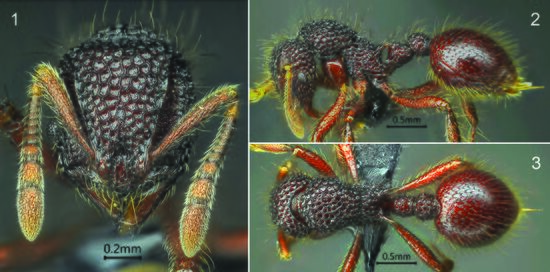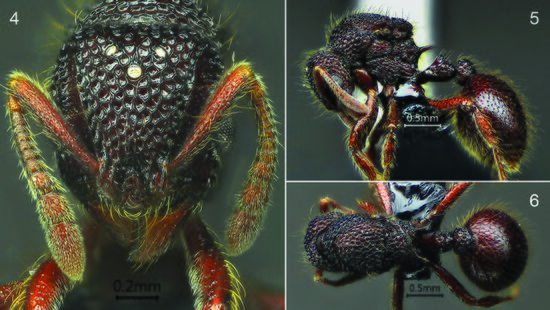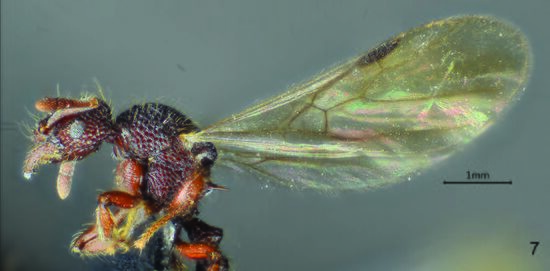Lordomyrma jingpo
| Lordomyrma jingpo | |
|---|---|
| Scientific classification | |
| Kingdom: | Animalia |
| Phylum: | Arthropoda |
| Class: | Insecta |
| Order: | Hymenoptera |
| Family: | Formicidae |
| Subfamily: | Myrmicinae |
| Tribe: | Crematogastrini |
| Genus: | Lordomyrma |
| Species: | L. jingpo |
| Binomial name | |
| Lordomyrma jingpo Liu, Xu & Hita Garcia, 2021 | |
All individuals known for this species originated from a single nest containing 12 workers, 1 queen and 3 winged females found within soil, classified as latosol. The site was within a fragmented valley lowland rainforest.
Photo Gallery
Identification
This species is closest to Lordomyrma reticulata (Figs. 25, 108), but its first gastral segment smooth and shiny, with sparse piliferous small punctures; body bicolored, head, mesosoma and waist blackish brown, gaster reddish brown; forecoxae lateral side smooth and shiny. The new species is also similar to Lordomyrma idianale (Figs. 106-107), but propodeal spines downcurved in profile view; head dorsum coarsely uniformly reticulate, without incorporated traces of longitudinal striae between the antennal scrobes.
Keys including this Species
Distribution
Latitudinal Distribution Pattern
Latitudinal Range: 24.68° to 24.68°.
| North Temperate |
North Subtropical |
Tropical | South Subtropical |
South Temperate |
- Source: Liu, Xu & Hita Garcia, 2021
Distribution based on Regional Taxon Lists
Palaearctic Region: China (type locality).
Distribution based on AntMaps
Distribution based on AntWeb specimens
Check data from AntWeb
Biology
Castes
Nomenclature
The following information is derived from Barry Bolton's Online Catalogue of the Ants of the World.
- jingpo. Lordomyrma jingpo Liu, Xu & Hita Garcia, 2021: 3, figs. 1-7 (w.q.) CHINA (Yunnan).
Type Material
- Holotype worker: China, Yunnan Province, Yingjiang County, Nabang Town, Palan Village, 24.6831°N, 97.5858°E, 590 m, collected from a nest in soil in valley lowland rainforest, 22. III. 2015, Ying Zheng leg., No. A15-381 (Southwest Forestry University, Kunming, China).
- Paratypes: 11 workers, 1 queen and 3 winged females, from the same nest of holotype worker and with the same data (Southwest Forestry University, Kunming, China; Guangxi Normal University).





